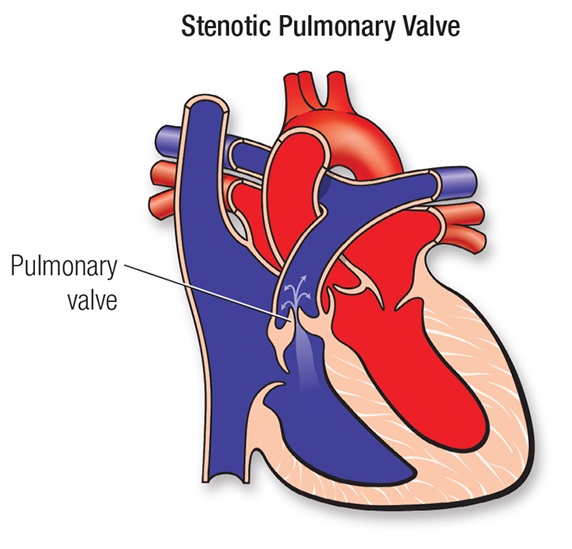Pulmonary stenosis is a narrowing of the pulmonary valve. This means the right ventricle has to work harder to pump blue blood into the pulmonary artery and so to the lungs to pick up oxygen.
Pulmonary valve stenosis: symptoms, causes and diagnosis
What is a pulmonary valve stenosis?
It is a condition where the pulmonary valve is thickened or fused and does not open normally. It causes increased work and strain to the right sided pumping chamber, the right ventricle. The pulmonary valve allows blood to flow freely from the right ventricle into the lung arteries and the lungs but prevents any back flow of blood while the heart is relaxing.
What causes pulmonary valve stenosis?
The exact cause of this condition is not known in many children. In some children it can be associated to syndromes, as Noonan syndrome or Williams syndrome. Additionally some infections developed in the womb (rubella, etc) can cause it. In some children it is not present in isolation but may be present in association with other cardiac defects.
How is the heart affected?
Normally the blood flow from the right ventricle into the lung arteries freely. In pulmonary valve stenosis, the valve is not opening fully and this causes the heart to have to work harder in order to ensure that enough blood is flowing across the narrow valve. The heart can initially cope if the valve is not too narrow but over time the right ventricle may become too tired and the heart muscle can weaken.
How can pulmonary valve stenosis affect my child?
Children with mild pulmonary valve stenosis have no symptoms and they may only be diagnosed if a murmur is heard during a general examination. In children with moderate degrees of stenosis, the pulmonary valve may become more narrow over time, particularly in the first year of life. Children with moderate pulmonary stenosis will have a loud heart murmur and may develop symptoms (breathlessness, increased fatiguability) while under intense physical stress. Children with severe pulmonary stenosis usually have symptoms during exercise (chest pain, tiredness, palpitation) and they may develop symptoms at rest when the stenosis is very severe. In babies with severe stenosis a blue appearance of the skin, lips and fingers may appear due to a drop in the oxygen content in the blood (cyanosis).
Can pulmonary stenosis go away?
In children with mild degrees of pulmonary stenosis, it is common occurrence that the stenosis might improve over time. However, children with even mild pulmonary stenosis require lifelong follow-up as the pulmonary valve may become stiffer and therefore work less sometimes later on in adult life.
How is pulmonary valve stenosis diagnosed?
It is diagnosed by clinical examination and echocardiography. An ECG is also frequently performed to see if there is any increased thickening of the right ventricle. Some children may require a chest CT or a cardiac MRI to better understand the location of the stenosis and to better understand any eventual associated cardiac defect if present.
What can be done about the pulmonary valve?
Children with mild and moderate degrees of this condition only require ongoing monitoring with clinical appointments and echocardiography. Children with severe pulmonary stenosis require treatment of the stenosis as this will ultimately affect the working conditions of the right ventricle, at which point the treatment might become more risky. The great majority of children and adolescents with this condition can benefit by a key hole treatment. Using this technique an empty sterile tube (a catheter) which has a an empty ballon at the tip is advanced trough the valve and the ballon is inflated (angioplasty) while across the valve so that the valve can be forcefully stretched open. The procedure is briefly shown in the video below.
Even though the procedure is very effective at relieving the stenosis it does not make the pulmonary valve normal. The procedure may cause a mild leakage of the pulmonary valve, which is usually very well tolerated. Some children may need surgery if the ballon angioplasty is not effective or if the size of the valve is too small to start with.
What activities can my child do?
Children with mild pulmonary valve stenosis and many with moderate pulmonary stenosis can undertaken any type of physical activity. Children with significant pulmonary valve stenosis will have to have their activity restricted to some extent depending on the function of the right ventricle and presence of additional symptoms, as well as depending on the type and intensity of the sport.
What will my child need in the future?
The long-term outlook for children with this condition is excellent, whether they have required balloon angioplasty or surgical treatment. No medicines are required and a very small number of children may require further procedures later on in adult life. Children with treated pulmonary valve stenosis will require regular ongoing follow-up by a paediatric cardiologist.


